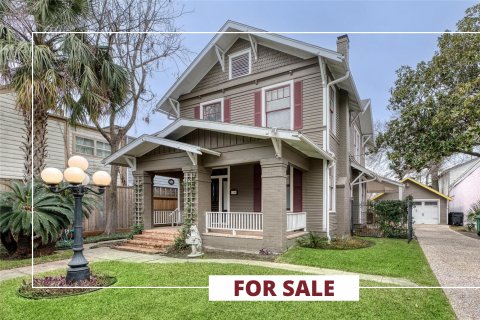Houston’s Hip Historian and His Old Yellow History Bus: Mister McKinney is a Dapper Force Building a New Generation of Preservationists
BY Catherine D. Anspon // 07.05.18Mister McKinney explores the archive of The African American Library at the Gregory School in Houston's historic Fourth Ward. (Photo by Max Burkhalter)
Cross obsessive historical knowledge about Houston’s past with the showmanship of P.T. Barnum, toss in an open-air school bus, and you have R.W. McKinney. Or, as he is more widely known, Mister McKinney — the founder and brand ambassador of Mister McKinney’s Historic Houston.
Mister McKinney is a model for the self-made and civic-minded. In less than 20 years, he has turned theater studies at the University of Houston and facility manager gigs at the Alley Theatre and Theatre Under The Stars into a widely hailed role as an educator and scholar — the dapper resource for Houston history, its personages and kingmakers, landmarks and palatial residences.
For any neighborhood, he can adroitly spin anecdotes from vanished decades. Take a drive with him through Memorial Park, for example, and you’ll learn what wonder of the world was planned for the site by Judge Roy Hofheinz, before city fathers and a feisty Ima Hogg intervened.
He’s visible as lecturer at Rice University’s Glasscock School of Continuing Studies, where he’s been paired with architectural historian Stephen Fox, whom he cites as inspiration. He serves on the boards of nonprofits spanning the historic (including Bellaire Historical Society and La Porte Bay Area Heritage Society) to the thespian (Miller Outdoor Theatre and Talento Bilingüe de Houston). This impassioned mission is financed largely by McKinney himself, augmented by occasional corporate sponsorships and modest tour fees, for his brand is not (yet) a nonprofit.
But it’s McKinney’s turn as ringleader of the jaunty tours in a yellow open-air 1988 International school bus — the Houston History Bus — that piqued our interest. Last December, we went on the Merry Mansions trek through River Oaks, with narration by Mister McKinney and unforgettable bus driver/personality Miss Alice behind the wheel.
We learned who built the biggest home in River Oaks in the 1930s and why; and saw the surprisingly understated house where Houston’s greatest architect, John Staub, lived.
A History of Mister McKinney
One evening, over a signature Mister McKinney Hendrick’s Gin cocktail at the Houston Club, McKinney waxed poetic about the Hines-built One Shell Plaza building that now houses the private club, as well as tales of the city builders behind skyscrapers visible from the 49th floor. Most intriguing was the story of the wheeling and dealing between Jesse Jones and Andrew Mellon, back in 1912, that yielded the 1929 Gulf Building.
As he tells it, his own story of becoming a historian started with free walking tours for kids and adults in 2002, when he was working downtown as facilities manager at the Alley. Taking as his source oral history notes from business owners and the authoritative 1990 AIA Houston Architectural Guide written by Stephen Fox, he led curiosity seekers down streets in search of narratives extending back to the 19th century.
But the historian’s journey actually began years before that, when he was an inquisitive junior high student who was dropped off with his siblings at the downtown Houston Public Library by their divorced single mom. McKinney migrated over to the Julia Ideson library, where the Texas Room and its treasures held sway.
“Maps at the Julia Ideson Building’s Texas Room have always helped me retain Houston’s past,” he says. “I used to sit and look at a map for hours, absorbing every bit of it. They were so well drawn, and I had so many questions … I taught myself how to find the answers. I would just keep searching, looking at newer maps of the exact same area, and view the aerial photo collection for the answer.”
Now his life has come full circle. He serves on the board of the Julia Ideson’s Friends of the Texas Room and raises funds and awareness for the Houston Metropolitan Research Center (HMRC), so other kids can have the same experiences.
“There was no Houston History 101 growing up, so I taught myself the history of Houston’s growth and have spent the last three decades perfecting it,” he says.
“This is all original content that I’ve spent years researching and adding to tell a story of Houston’s historic past.”
Building Preservationists
Education is McKinney’s tag line: “Ensuring Houston’s future doesn’t forget its past.” At its heart, the Houston History Bus aims to appeal to youngsters and drum up the next generation of preservationists. It’s no accident that his inaugural children’s book, planned for 2019, will be titled after Judge Roy Hofheinz’s life: The Can-Do Kid.
That bigger-than-life Astrodome dreamer and builder is the man whose 1952 mayoral campaign business card McKinney carries with him as a talisman. Given McKinney’s own penchant for navy blazers, carefully pressed trousers, pocket squares, and other natty touches; his shiny, branded Mister McKinney name tag; and his ability to read his audience and convey information in a theatrical and enticing way, one suspects he sees more than a little of Judge Roy Hofheinz in his own life.
What’s next for Mister McKinney? He plans to tap into his background in regional theater, which began as a child, then carried over into his college years.
“I was in dramatic plays like Twelve Angry Men and musicals like Cole Porter’s smash hit Anything Goes and Gershwin’s Crazy For You,” he says. “I’ve always wanted to write a musical based on the life of Jesse H. Jones and other iconic Houstonians, to tell the stories of Houston’s past and all the people that contributed to the city’s growth — to combine both of my loves, Houston history and the performing arts.”

Mister McKinney’s Guide
Houston’s Most Illustrious Street
Mister McKinney: When people think of mansions in Houston, the iconic River Oaks neighborhood comes to mind. There are remarkable homes from Houston’s who’s who, like Ima Hogg’s 1928 Bayou Bend, designed by River Oaks’ most celebrated architect, John Staub.
Inwood Street (named for the Inwood, New York, country club founded in 1901) gets the most interesting reaction when we tour River Oaks. It was home to wildcatter Hugh Roy Cullen, with his massive mansion on the corner of Inwood and River Oaks Boulevard, which started construction during the Great Depression in 1933 and completed in 1935; it was said he built the home larger than he needed so he could employ more contractors during the Depression.
Homebuilder Katharine Mott and her business partner/husband built for their family in 1930 at 3325 Inwood. Other notable Inwood mansions include the home of George R. Brown and Alice Pratt Brown (1933, by J.T. Rather Jr.) at 3363 Inwood; and Will Clayton’s home, the first home built in River Oaks, in 1924, at 3376 Inwood (architects Briscoe & Dixon).
Historical Montrose
Mister McKinney: The once-majestic Montrose area still has a handful of its historic mansions intact, thanks to the development of the University of St. Thomas campus, starting in 1946 with the purchase of the John Wiley Link Mansion at 3800 Montrose Boulevard. Known today as the Link-Lee Mansion, the name is shared with oilman Thomas Peter Lee, who would buy the mansion from the Link family in 1916.

Mr. Link was a lawyer, the former Mayor of Orange, Texas, vice president of the Kirby Lumber Company, president of our regional Dr. Pepper Bottling Company, and, of course, president and driving force behind the Houston Land Company’s creation of the 1911 Montrose addition.
J.W. Link would also serve as the president of the 1912 No-Tsu-Oh Carnival, which was patterned after the New Orleans Mardi Gras and held in Houston from 1899 to 1915. His son, Harold Link, and a friend down the street, Howard Hughes Jr., would serve in the annual cotton harvest carnival as pages in full costume.
University of St. Thomas would also save the Howard Hughes family’s last home, built in 1918 at 3921 Yoakum, where the teenage Hughes grew up. (The Hughes family moved to this address from apartment 2A in the luxury Beaconsfield Apartments, still there today at 1700 Main Street, built in 1911.) The famed aviator and movie star actually kept the Montrose home after he left for Hollywood, so that his aunt could live there. The University of St. Thomas bought the home in 1952, originally for their social science building, and it now houses their theology department.
Just to the north of these two homes was the home where funeral director/undertaker Sid Westheimer, nephew of Mitchell Louis Westheimer (Michael), who the street is named after. (Michael lived on the farm where Lamar High School now sits.) Sid’s home, built in 1919 at 3700 Montrose Boulevard with its iconic green roof, is now a law firm.
Oil magnate and Humble Oil co-founder Walter W. Fondren’s 1923 mansion by Alfred C. Finn, a masterpiece in the Prairie Style, still presides over the neighborhood. Sited at 3410 Montrose Boulevard, it was restored and reborn as La Colombe d’Or, a Houston luxury hotel fixture for the past 30 years.
The loudest, most flamboyant, and best known of the Humble clan (today’s ExxonMobil) was Ross S. Sterling, 31st Governor of Texas. In 1914, he began developing Rossmoyne, a private subdivision with large landscaped esplanades to the south of Montrose. His Alfred C. Finn-designed mansion, completed in 1916, still stands intact, relatively hidden, at 4515 Yoakum Boulevard, now bordered by the Southwest Freeway’s massive concrete wall.
And, just down the street, The Kinkaid School’s second location was built in 1924 on Richmond Avenue where a post office now resides. The school was there until their new campus was built in 1957 in the rural Piney Point area of Houston, to the far west.
And how does Mister McKinney want his history to read?
Mister McKinney: I hope to be remembered for my work with youth. I have dedicated the last 16 years to Mister McKinney’s Historic Houston’s tag line, “Ensuring Houston’s future doesn’t forget its past,” and I’m committed to it. I know I’m making a difference in the lives of these students because we test what they’ve retained, and one question leads to more questions. They’re learning. They’re curious about the area they live in.
My hope has always been to breed future preservationists, so when they are older and in a position to save — or at least speak up for — a historic Houston structure in jeopardy of being torn down, they will remember what Mister McKinney taught them and fight to save it.
Next up are the Titans and Tycoons Tours to Forest Park Lawndale Cemetery (the final two are Sunday, July 22 and Sunday, August 19), underwritten by Dignity Memorial. Tour details are on Mister McKinney’s Historic Houston Facebook page.
A Never-Ending Mission
Mister McKinney: It is important to say that no one knows everything about Houston’s history, because none of us were here 182 years ago. People are kind to me; they will stop me in the streets after recognizing me from TV and ask questions about Houston history. I answer a few and give them my email and cell if they think of others.
I also get called “Mister Houston” a lot — and I am quick to remind people there is only one “Mister Houston,” and I’m not talking about General Sam Houston. It’s Jesse H. Jones, of course. I am happy being Mister McKinney of Mister McKinney’s Historic Houston.
They smile and ask, “Who’s Jesse H. Jones?” I give them a pass for one of my free tours so they can find out. With 6.5 million people in the Houston area, my job is never done.
On Being a Showman
Mister McKinney: I’m not your typical historian. I’ve been called on the radio the “José Altuve of Houston history” and the “walking Google for Houston history.” I dress differently, use an open-air bus as my classroom, and with background in theater, I tell a story in a much different way.
In addition to throwing out facts about Houston history, I am always reading my audience to make sure they’re engaged and learning. That’s paramount, or I’m doing something wrong.
Architectural Matters
Mister McKinney: Our Houston architecture is a record of our growth and a testament to our can-do spirit of conquering the swampy, hot Houston landscape. It is near impossible to not talk about Houston’s past, its growth, without pointing out the local architecture.
The residential styles of homes tell a story about Houston’s growth — ethnically in some cases. The socioeconomic status in most all cases, whether rich or working class, and footprint of a neighborhood give historians a pattern of the city’s overall development. That residential growth can also dictate the commercial growth. I’ve always been fascinated with how Houston evolves.
Lost Houston
Mister McKinney: I serve on the board of the Harris County Historical Commission, the group responsible for historical markers around town, and my specific focus is townships, municipalities, and settlements. Many of these remnants of early Houston are gone and certainly forgotten.
The Houston Heights, founded in 1891 and annexed by the City of Houston in 1918, comes to most people’s mind. But I like talking about places like Brunner, Texas, in the far West End, absorbed by Houston by 1915, and Genoa, Texas, in the southeast, just northwest of where the 1917 Ellington Field is today. The remains of Genoa and the town to the west called Almeda, Texas, are evident with the path that connected them, Almeda-Genoa Road.
The Houston-area town of Dairy to the southwest is a fun story kids in Southwest Houston like to hear. That settlement would be forced to change its name to Alief, Texas, in 1904, when they wanted a U.S. Post Office, since a Dairy, Texas, already existed in the Western part of the state.
This area had a town to the north of it called Satsuma, for the Satsuma mandarin oranges grown there, but it was also known as Ashford, Texas, which is where the popular north-to-south connector road, Dairy Ashford Road, gets its name. Sadly, these areas had small populations, and so much of this history is gone.
I do what I can to bring it back and make sure when kids in the area are driving on these roads, they think about those that came before them in rural Houston. It makes you think, and that’s a good thing.
Signature Tours
The ultimate compliment was when John Staub’s adult grandchildren attended the tour and said they learned so much about their beloved grandfather.
Mister McKinney: The Houston History Bus has really expanded my ability to teach even more people about local history. I started in August of 2017 with my original walking tour, Mister McKinney’s Historic Houston. We then had fun with historic Haunted Houston in October, then The Houstonian Hotel Club and Spa came calling and wanted to partner with Mister McKinney’s Historic Houston on a tour of Merry Mansions — the history of John Staub homes in River Oaks, since they had the old Staub-designed Lawrence Reed house, now called the Manor House, on their site.
Their tour included special Houston history cocktails. I also partnered with HISD’s Pre-K Pals Toy Drive in November and December to do free Christmas light tours of River Oaks when you donated a new toy for pre-school kids. The ultimate compliment was when John Staub’s adult grandchildren attended the tour and said they learned so much about their beloved grandfather.
Our next big project was a partnership with the Fifth Ward Community Redevelopment Corporation on tours of historic Fifth Ward, dating back to 1865, for Black History Month. Free to the public, the 10 tours filled up fast. To celebrate Women’s History Month in March, we partnered with the Pan American Round Table for a tour called Houston Women’s History, which had over 258 Houston women featured; we had to narrow it down to just 130 leading ladies for our one hour tour, but we educated a lot of men, women, and especially young girls about Houston women that made our city the success that it is.
In April and early May, we celebrated Miller Outdoor Theatre’s 95th birthday with free tours of historic Hermann Park (dating back to 1914), the Museum District, and the 1945 Texas Medical Center. Those six weekend tours did very well, and we will certainly bring back the program.
For updates on Mister McKinney’s tours, follow the historian on Facebook, Twitter, and Instagram.
























_md.jpg)












_md.jpg)
_md.jpg)







_md.jpg)





_md.jpg)







_md.jpg)





_md.jpg)








_md.jpg)

